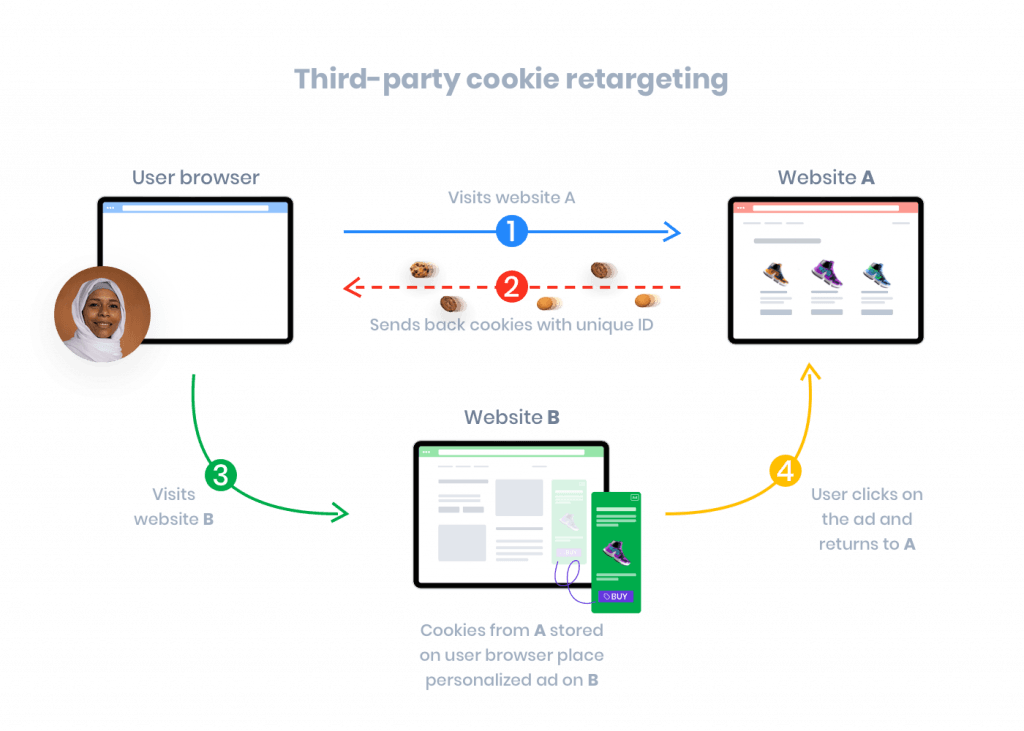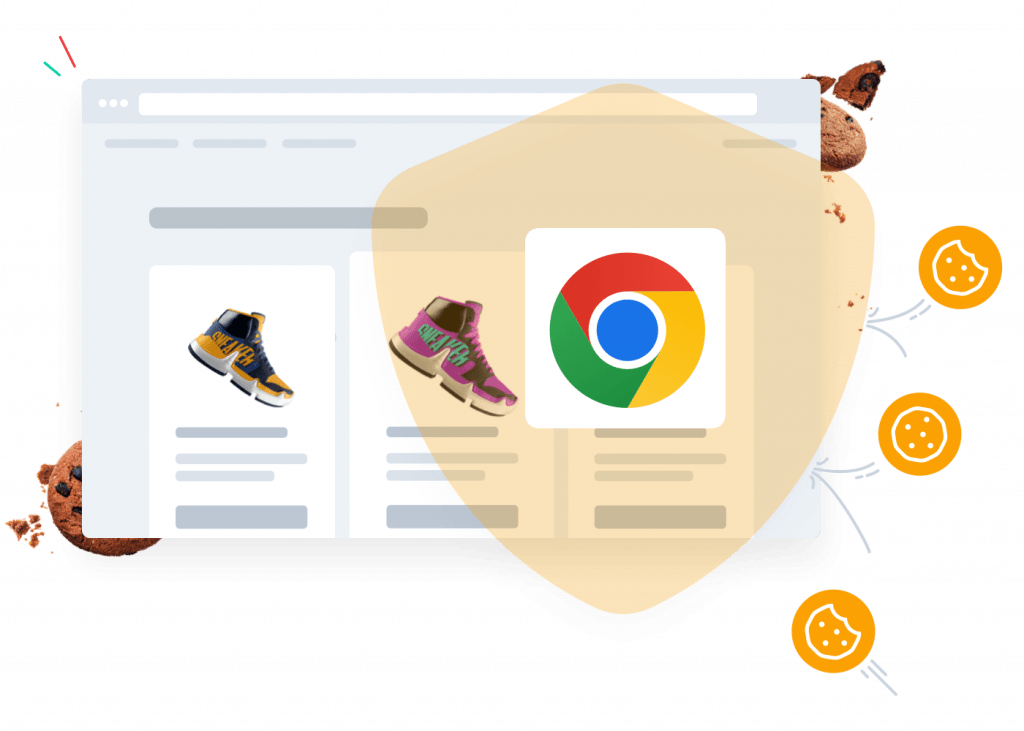Third-party cookies are disappearing: what is the impact for you?

Following other browsers, Google Chrome will also stop providing third-party cookies in 2024. Our online privacy improves as a result, but for marketers, this change is anything but a joke. Combell provides you with insights and solutions.
Third-party cookies are disappearing, but why?
It goes like this: browsers such as Mozilla Firefox and Apple Safari have been blocking third-party cookies for a while now. Google's browser, Chrome, is now following suit. Google refers to this as a gradual phase-out. By the end of 2024, third-party cookies will disappear in Chrome as well.
The disappearance of third-party cookies is closely related to increasingly stringent privacy regulations. Consumers, not entirely without reason, are becoming more and more concerned about their privacy and how they are tracked on the internet.
You have to admit that there is something to be said about the selling and sharing of (personal) data.
Listen
Computer scientist Jeroen Baert on the decline of cookies (in Dutch).
GDPR
Governments are asking themselves the same questions. They want to protect consumers. This is partly why the GDPR rules were rolled out. In response, browsers are now blocking third-party cookies.
With the disappearance of third-party cookies, marketers and advertisers will have to rethink their marketing strategies. Specifically, this means that they will have to collect data through other means, which is still possible. For example, they can use first- and zero-party cookies.
Combell is working behind the scenes on various solutions. We are considering new products or interesting options within our web hosting, so that you can continue to collect and store data.
Just to refresh your memory: what are third-party cookies?
In general, cookies are files stored on a computer by (other) websites. They keep track of information about a user's browsing behavior.
Third-party cookies, or simply '3rd party cookies,' are primarily used as marketing cookies. The biggest difference is that third-party cookies are exclusively placed by other parties, not by your own site or server.
Also read
Different types of cookies explained.
These cookies track browsing behavior and display personalized offers. They are third-party cookies that ensure you see advertisements for a particular car brand after you've just searched for that same brand. These cookies sometimes make you feel like you're being followed everywhere.

However, this doesn't mean that third-party cookies are not used for other reasons. Consider embedding social media on your site or fortifying your site against spam. These types of cookies are not solely related to marketing.
Example of a third-party cookie
Adding an X-feed to your blog. The company behind X (formerly Twitter) can track visitors' interactions with the feed via a cookie. Additionally, you gain an extra feature on your blog.
Impact on your marketing strategy
In this digital age, data collection and analysis are indispensable. A significant portion of your marketing strategy and data analysis relies on this.
Third-party cookies primarily focus on:
The disappearance of third-party cookies will have a significant impact on these areas. Data collection will need to occur in a different manner.
We hear you!
Our support colleagues, the account managers... They're often approached about this decision. It makes sense because many of our customers are heavily invested in marketing and online advertising. Here at Combell, we understand the concerns all too well.
That's why we're currently working behind the scenes on various solutions. We want to support our customers on a technical level, perhaps through new products or interesting options within our web hosting. So that you can continue to collect and store data.
We're currently doing our thing, but we'll be back soon with more information. You can count on Combell. 🙂

All these changes come with some difficulties. Fortunately, there are also opportunities! It's up to you to make the switch or to seek good guidance.
Explaining the difficulties:
Limited audience targeting
Through audience targeting, consumers are shown ads based on their online interests and browsing behavior. A third-party cookie is the technology behind audience targeting.
Without third-party cookies, you cannot display personalized advertising messages. However, audience targeting will not completely disappear; it will just yield much more limited results.
Remarketing without third-party cookies
Reaching out again to those who have previously visited your website—that's what remarketing means. Visitors who have visited a certain website will see ads from that previously visited site on other websites.
Remarketing is a popular advertising model. Unfortunately, you will no longer be able to use this tracking method via third-party cookies, leading to a much smaller reach for remarketing.
Difficulty in using cross-device targeting
Cross-device targeting allows advertisers to target users across different devices. Here's where the problem arises: by limiting third-party cookies, tracking users across different devices becomes more difficult.
Although we can track device usage through login information, it's important to note that Google only has access to a portion of this login data, requiring extrapolation to get a more complete picture.
As a result, cross-device targeting will become more challenging as third-party cookies disappear.
Explaining the opportunities:
Using first-party cookies
Indeed, audience targeting will change, but there's no need to panic. Marketing without cookies is not on the table at all. First- and zero-party cookies will continue to exist.
Those without the hefty budgets of Facebook or Google will need to focus more on this. Luckily, Google Analytics 4 (GA4) utilizes these cookies. So, you'll still be able to track what users are up to on your website.
You don't even need to make any special adjustments for this. Of course, you should start using GA4 as soon as possible. 😉
Moreover, first-party cookies are highly valuable because, compared to other cookies, they are much more flexible in storing data. The results via first-party cookies are therefore very relevant. You get a clear picture of how visitors are responding to your website.
You can collect data via first-party cookies in various ways. Think of:
Using zero-party cookies
Zero-party cookies will also remain. Make smart use of them! For example, in the newsletter signup process, you can inquire about your customers' interests.
Subscribers will share this data with you to receive interesting offers, discounts, and promos. They usually do this voluntarily or explicitly give permission. This is precisely why zero-party cookies feel completely different from the 'sneaky' third-party cookies.
At the same time, first- and zero-party cookies give you the opportunity to personalize your marketing strategy. You are more transparent about the data you process, which will increase customers' trust in your company.
Adjusting your marketing strategy
If you currently advertise on the internet through banners or social media, targeting the interests, hobbies, work, or previously visited websites of potential customers, then you need to consider a different approach.
Instead, you can start with contextual targeting. This means finding websites or topics that are relevant to your target audience and placing your ads there, matching what those users are interested in at that moment.
Google has also announced that they are working on an alternative to using third-party cookies. Through Sandbox, advertisers can still create personalized ads, but without using data about individual people.
Learn about Google's Privacy Sandbox in this video:
The idea behind this is to improve privacy. However, the downside is that you have less insight into how audiences are being assembled.
So, it may be more challenging to check why certain ads perform well or not.
Advertising with strong content
Now that your ads don't just appear everywhere with minimal effort, it's a good idea to take a closer look at their content.
Ensure your message is compelling and your Call To Action (CTA) is very clear. The stronger your content, the more you'll stand out among all the other advertisements.
Experimenting with server-side tracking
With third-party cookies disappearing, it's worth exploring the possibilities of server-side tracking.
With server-side tracking, data is collected and processed directly on the website or platform server, rather than on the user's browser. This means users don't need cookies, enhancing their privacy.
Server-side tracking can also provide more reliable and accurate data because it's less susceptible to ad blockers and other browser settings that block cookies.
Another advantage of server-side tracking is that it can help solve issues associated with third-party cookies, such as cross-device tracking and tracking users across different browsers.

Using browser fingerprinting
Browser fingerprinting is an innovative way to track users on the internet. It involves using various device characteristics, such as screen size and internet browser, to assign a unique identification to a user.
This enables tracking without using cookies, respecting privacy laws.
Another method is utilizing data from advertisements and marketing through specialized programs (APIs) on websites or customer relationship management systems (CRMs). This allows companies to still gather information without violating privacy regulations.
The Conversions API developed by Meta for Server-Side Google Tag Manager (GTM) is a prime example of this.
Take on the Challenge
Redefining your marketing strategy, exploring different advertising methods, trying out new tools... the disappearance of third-party cookies brings about a lot of change. That's for sure!
However, it's essential to realize that marketing without third-party cookies is more of a challenge than completely impossible.
We're all adjusting to this new landscape. From Combell, we wish you success with this transformation. You're not alone in this; you can count on us too. Hopefully, this clear blog serves as a kind of guide.